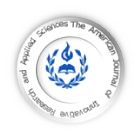



GENERAL INFORMATION

American Journal of Innovative Research & Applied Sciences

| ISSN: 2429-5396 (e) | www.american-jiras.com | |
| Web Site Form: v 0.1.05 | JF 22 Cours, Wellington le Clairval, Lillebonne | France |
| Web Site Form: v 0.1.05 | JF 22 Cours, Wellington le Clairval, Lillebonne | France |


ResearchBib, Google Scholar, SIS database, i.f.s.i.j, Scribd, IISJ, Eurasian Scientific Journal Index (ESJI), Indianscience.in, arastirmax, Directory of Research Journals Indexing, Pak Academic Sesearch, AcademicKeays, CiteSeerX, UDL Library, CAS Abstracts, J-Gate, WorldCat, Scirus, IET Inspec Direct, and getCited
Indexed by:
| HOME || ABOUT US || ARCHIVES || AIMS AND SCOP || AUTHORS || REVIEW|| SUBMIT MANUSCRIPT || EDITORIAL BOARD || CONTACT US |
| HOME | ABOUT US | ARCHIVE | AIMS AND SCOP | AUTHORS | REVIEW | SUMIBMIT MANUSCRIPT | EDITORIAL BOARED | PUBLICATION FEE |
| | ARTICLES | Am. J. innov. res. appl. sci. Volume 8, Issue 4, Pages 113-119 (April 2019) |
| Research Article |
American Journal of innovative
Research & Applied Sciences
Research & Applied Sciences
ISSN 2429-5396 (Online)
OCLC Number: 920041286
OCLC Number: 920041286

| APRIL 8 | N° 4 | 2019 |
Authors Contact
*Correspondant author and authors Copyright © 2019:
| Rachida Afgane *1 | Mohammed Jmili 2 | Faiza Benjelloun 1 | Farah El Hassani 3 | et | Abderrahim Lahrach 1 |
*Correspondant author and authors Copyright © 2019:
| Rachida Afgane *1 | Mohammed Jmili 2 | Faiza Benjelloun 1 | Farah El Hassani 3 | et | Abderrahim Lahrach 1 |
Affiliation.
1 Laboratoire Géoressources et Environnement | Université Sidi Mohamed Ben Abdellah | Fès | Maroc |
2. Régie Autonome Intercommunale De Distribution D'eau Et D'électricité De Fès | Maroc |
3. Inspection Régionale de l’Urbanisme | de l’Architecture et de l’Aménagement du Territoire | Fès-Meknès | Maroc |
This article is made freely available as part of this journal's Open Access: ID | Rachida-ManuscriptRef.1-ajira300219 |
RESUME
Introduction: La station d'épuration des eaux usées de la ville de Fès, est la plus grande station au Maroc, et traite tout type d'eau usée. A la sortie de STEP-Fès l'eau épurée, est accompagnée par une production de quantités non négligeables de boues dont il faut s'en débarrasser, ainsi STEP-Fès a choisie de les éliminer en les mettant en décharge, s'avère une technique peu valorisante et est légalement interdite dans de nombreux pays. La valorisation des boues de STEP-Fès est devenue une priorité régionale, vue les quantités énormes produites, et les dangers qu'elles peuvent générer vue leur composition complexe et hétérogène. Objectif: C’est dans cette optique que vient ce présent travail qui vise à suivre le devenir des boues de STEP-Fès avant et après leur mise en décharge ainsi que les caractériser par l'analyse de leurs paramètres physico-chimiques et bactériologiques, afin de prendre une décision sur la possibilité de les valoriser avec l'une des filières répondant à la protection de l'environnement et la minimisation de la pollution. Résultats: L'analyse de quelques paramètres physico-chimiques des boues en fonction du temps a montré que les boues stockées une durée de temps sont les plus favorables pour la valorisation énergétiques et agricoles par rapport à celles obtenues directement après le traitement les eaux usées et celles envoyées à la décharge qui ont un contact direct avec d'autres déchets, malgré cela nécessitent des améliorations au niveau de la siccité des boues, et leur structure. La composition de la boue de stockage en éléments traces métalliques est conforme aux normes et ne reflète aucun danger dans leur utilisation pour l'épandage ou le compostage, ainsi l'analyse des caractéristiques bactériologiques ont souligné la présence des œufs d'helminthes qui par leur présence peuvent contaminer les sols agricoles. Conclusion: La valorisation des boues de la station d’épuration des eaux usées de la ville de Fès est encouragée, mais il faut trouver des solutions en ce qui concerne les contraintes réglementaires et juridiques fixant les modalités de leur utilisation, ainsi que des contraintes techniques et économiques.
Mots clés: STEP-Fès, boues activées, valorisation, épandage, compostage, siccité, mise en décharge.
ABSTRACT
Background: The sewage treatment plant of the city of Fez, is the largest station in Morocco, and treats all types of waste water. At the end of STEP-Fez the purified water, is accompanied by a production of significant amounts of mouths which must be discarded, technical little value and is legally prohibited in many countries. The valorization of sludge from STEP-Fès is considered as a regional priority, a vision of the resources produced, and the dangers that they can generate their complex and heterogeneous composition. Objective: It is in this perspective that this present work aims to follow the fate of STEP-Fès sludge before and after their landfill as well as to characterize them by the analysis of their physico-chemical and bacteriological parameters, in order to make a decision on the possibility of valuing them with one of the sectors responding to the protection of the environment and the minimization of pollution. Results: The analysis of some physicochemical parameters of sludge as a function of time showed that the sludge stored for a period of time is the most favorable for energy and agricultural recovery compared to those obtained directly after wastewater treatment. Those sent to the landfill that have direct contact with other wastes, in spite of this, require improvements in the dryness of the sludge, and their structure. The composition of the metal trace element storage sludge is in accordance with the standards and does not reflect any danger in their use for spreading or composting, so the analysis of the bacteriological characteristics has highlighted the presence of helminthes eggs which by their presence can contaminate agricultural soils. Conclusion: Sludge recycling at the wastewater treatment plant in the city of Fez is encouraged, but solutions must be found for the regulatory and legal constraints on how to use them, as well as technical constraints and economic. Key words: STEP-Fes, activated sludge, recovery, spreading, composting, dryness, landfilling.
Introduction: La station d'épuration des eaux usées de la ville de Fès, est la plus grande station au Maroc, et traite tout type d'eau usée. A la sortie de STEP-Fès l'eau épurée, est accompagnée par une production de quantités non négligeables de boues dont il faut s'en débarrasser, ainsi STEP-Fès a choisie de les éliminer en les mettant en décharge, s'avère une technique peu valorisante et est légalement interdite dans de nombreux pays. La valorisation des boues de STEP-Fès est devenue une priorité régionale, vue les quantités énormes produites, et les dangers qu'elles peuvent générer vue leur composition complexe et hétérogène. Objectif: C’est dans cette optique que vient ce présent travail qui vise à suivre le devenir des boues de STEP-Fès avant et après leur mise en décharge ainsi que les caractériser par l'analyse de leurs paramètres physico-chimiques et bactériologiques, afin de prendre une décision sur la possibilité de les valoriser avec l'une des filières répondant à la protection de l'environnement et la minimisation de la pollution. Résultats: L'analyse de quelques paramètres physico-chimiques des boues en fonction du temps a montré que les boues stockées une durée de temps sont les plus favorables pour la valorisation énergétiques et agricoles par rapport à celles obtenues directement après le traitement les eaux usées et celles envoyées à la décharge qui ont un contact direct avec d'autres déchets, malgré cela nécessitent des améliorations au niveau de la siccité des boues, et leur structure. La composition de la boue de stockage en éléments traces métalliques est conforme aux normes et ne reflète aucun danger dans leur utilisation pour l'épandage ou le compostage, ainsi l'analyse des caractéristiques bactériologiques ont souligné la présence des œufs d'helminthes qui par leur présence peuvent contaminer les sols agricoles. Conclusion: La valorisation des boues de la station d’épuration des eaux usées de la ville de Fès est encouragée, mais il faut trouver des solutions en ce qui concerne les contraintes réglementaires et juridiques fixant les modalités de leur utilisation, ainsi que des contraintes techniques et économiques.
Mots clés: STEP-Fès, boues activées, valorisation, épandage, compostage, siccité, mise en décharge.
ABSTRACT
Background: The sewage treatment plant of the city of Fez, is the largest station in Morocco, and treats all types of waste water. At the end of STEP-Fez the purified water, is accompanied by a production of significant amounts of mouths which must be discarded, technical little value and is legally prohibited in many countries. The valorization of sludge from STEP-Fès is considered as a regional priority, a vision of the resources produced, and the dangers that they can generate their complex and heterogeneous composition. Objective: It is in this perspective that this present work aims to follow the fate of STEP-Fès sludge before and after their landfill as well as to characterize them by the analysis of their physico-chemical and bacteriological parameters, in order to make a decision on the possibility of valuing them with one of the sectors responding to the protection of the environment and the minimization of pollution. Results: The analysis of some physicochemical parameters of sludge as a function of time showed that the sludge stored for a period of time is the most favorable for energy and agricultural recovery compared to those obtained directly after wastewater treatment. Those sent to the landfill that have direct contact with other wastes, in spite of this, require improvements in the dryness of the sludge, and their structure. The composition of the metal trace element storage sludge is in accordance with the standards and does not reflect any danger in their use for spreading or composting, so the analysis of the bacteriological characteristics has highlighted the presence of helminthes eggs which by their presence can contaminate agricultural soils. Conclusion: Sludge recycling at the wastewater treatment plant in the city of Fez is encouraged, but solutions must be found for the regulatory and legal constraints on how to use them, as well as technical constraints and economic. Key words: STEP-Fes, activated sludge, recovery, spreading, composting, dryness, landfilling.
|
VALORISATION DES BOUES DELA STATION D’EPURATION DES EAUX USEES DE LA VILLE DE FES
VALORIZATION OF WASTEWATER PURIFICATION STATIONS IN THE CITY OF FES
| Rachida Afgane *1 | Mohammed Jmili 2 | Faiza Benjelloun 1 | Farah El Hassani 3 | et | Abderrahim Lahrach 1 |. Am. J. innov. res. appl. sci. 2019; 8(4):113-119.
| PDF FULL TEXT | | XML FILE | | Received | 20 February 2019 | | Accepted | 23 March 2019 | | Published | 03 April 2019 |
VALORIZATION OF WASTEWATER PURIFICATION STATIONS IN THE CITY OF FES
| Rachida Afgane *1 | Mohammed Jmili 2 | Faiza Benjelloun 1 | Farah El Hassani 3 | et | Abderrahim Lahrach 1 |. Am. J. innov. res. appl. sci. 2019; 8(4):113-119.
| PDF FULL TEXT | | XML FILE | | Received | 20 February 2019 | | Accepted | 23 March 2019 | | Published | 03 April 2019 |